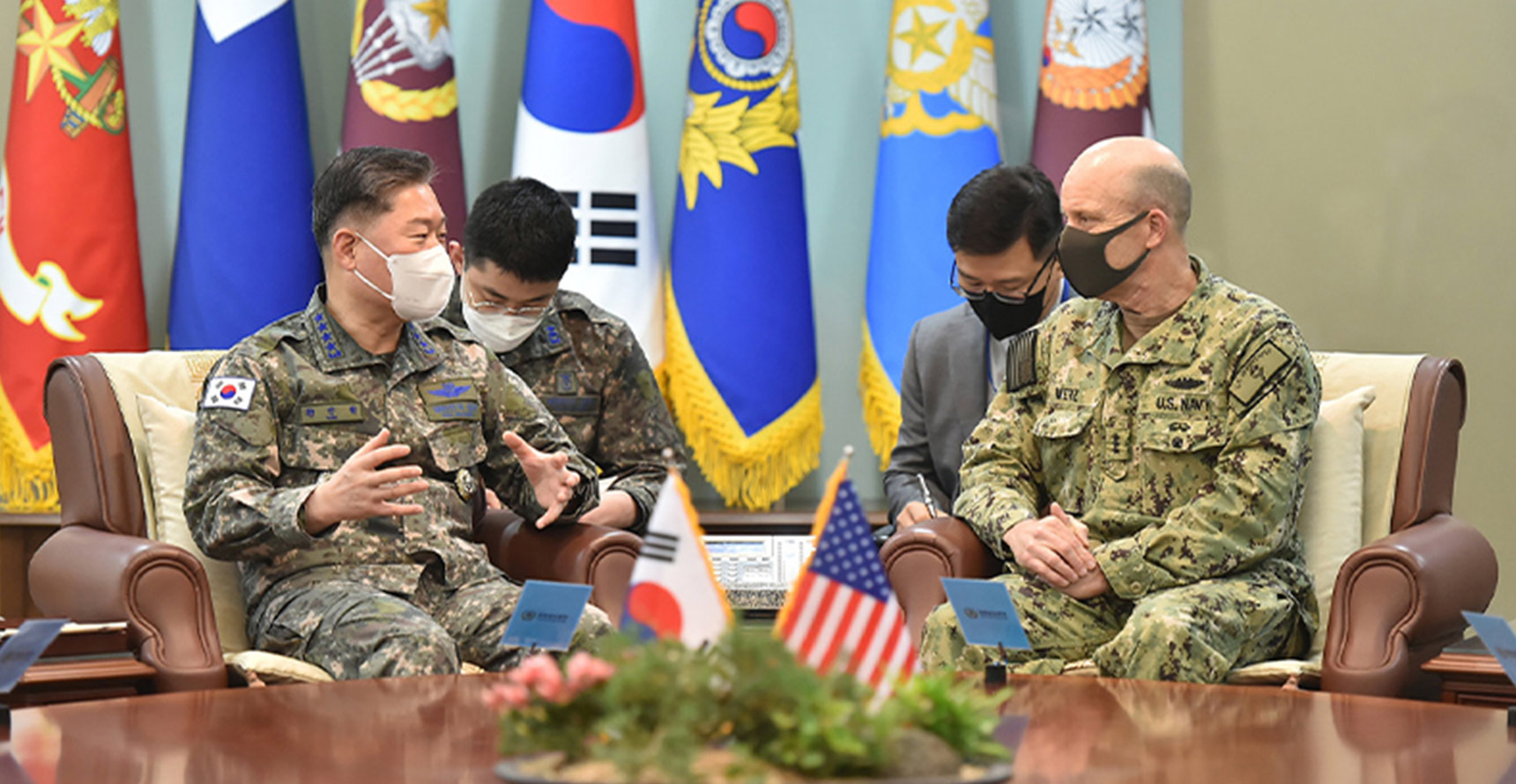Would U.S.-South Korea Conventional Operations Trigger North Korean Nuclear Escalation?

North Korea has made nuclear weapons a central component of its national defense strategy. Its commitment to building a diverse, survivable nuclear arsenal has shown remarkable progress over the past few years, demonstrated by a recent test of a solid-fuel intercontinental ballistic missile (ICBM) capability and numerous test launches of short-range ballistic missiles (SRBMs) that might be able to carry nuclear warheads. Its official nuclear doctrine, which was publicly revealed by its announcement of a new law in September 2022, heavily emphasizes the first use of nuclear weapons. It also simulated a nuclear strike against a hypothetical aggression by the United States and South Korea. Through its words and deeds, North Korea has consistently demonstrated its willingness and capability to use nuclear weapons as quickly as possible if necessary.
Washington and Seoul have responded to the danger of North Korean nuclear escalation by augmenting conventional strike capabilities, increasing the level of peacetime coordination on nuclear planning, and forward-deploying additional military assets. Should war occur, allied forces might attempt to conduct preemptive strikes against North Korea’s nuclear assets, such as ICBMs. Experts have debated the potential challenges and consequences of those strategies. Yet it is extremely likely that attacks that fall short of nearly perfect success—destroying almost all nuclear delivery vehicles—would trigger North Korean nuclear retaliation because Pyongyang has placed great importance on its nuclear arsenals and thus would see threats to its nuclear forces as existential threats to its security. As an alternative, allied forces may seek to deliberately avoid targeting nuclear assets while destroying North Korea’s conventional forces, with the hope that it could avoid triggering North Korean nuclear escalation. Whether such a strategy would succeed has not been widely explored by experts.
In my research, I use open-source literature to explore whether conventional operations by allied forces against North Korea’s ballistic missile forces would lead to Pyongyang’s nuclear use. Given the size of its nuclear warheads stockpile, the majority of North Korea’s land-based ballistic missiles, especially medium-range and short-range ballistic missiles, are likely to be assigned for conventional military missions. Attacking North Korea’s land-based missiles, however, could carry non-trivial risks of North Korean nuclear escalation, because some of those ballistic missiles are also crucial elements of Pyongyang’s nuclear deterrent.
The risk of escalation depends both on the distinguishability and survivability of those missiles. If allied forces are perfectly capable of identifying the missiles carrying nuclear warheads or the units assigned nuclear strike missions, then there would be a limited chance that the alliance’s military operations would inadvertently threaten Pyongyang’s ballistic missiles that have a nuclear role. The open-source literature, however, provides little detailed information on detectable clues that help identify a nuclear-tipped medium-range ballistic missile (MRBM) and SRBM. This implies that real-time identification could remain a significant challenge, hampering any potential effort to selectively target conventionally armed missiles. It is possible, therefore, that some of the nuclear-tipped MRBMs and SRBMs would be exposed to allied forces’ conventional military operations inadvertently.
Even with the identification problem, however, escalation risks might be negligible if North Korea’s ballistic missiles assigned nuclear missions are highly survivable—that is, if they could withstand an attack. Unfortunately, this may not be the case. Some of the ballistic missiles that are believed to have a nuclear role are liquid-fuel missiles, which require longer preparation for launch and more conspicuous supporting units than solid-fuel missiles. Even after considering several obstacles for successful tracking, therefore, there is a chance that those missiles would be successfully destroyed once exposed to allied force kinetic strikes. Taken together, allied force’s operations against those missiles might make Kim Jung Un fear the loss of a significant portion of his nuclear deterrent and thus force him to contemplate the use of them before their looming loss.
Military-technical drivers of escalation are not the entire story, however. Public statements on preemptive strikes by U.S. and South Korean policymakers could be a strong perceptual driver of inadvertent escalation. North Korean nuclear escalation would be more likely if Kim Jung Un, during peacetime, has a strong fear of allied forces’ preemptive attacks against his nuclear forces. Such fear is likely to be confirmed and strengthened every time he observes official statements by leaders of the United States and South Korea that imply preemptive attacks. Under this circumstance, even an isolated, inadvertent attack against the launchers carrying nuclear-tipped missiles or bases that house those missiles might be interpreted as a prelude to an incoming all-out strike by allied forces. Combined with its strategy of an early first nuclear use, U.S. and South Korean leaders’ public statements for deterrence may exacerbate Pyongyang’s fear of preemption, lowering the threshold for inadvertent nuclear escalation. In other words, rhetorical signals for peacetime deterrence may complicate escalation management during wartime.

North Korea celebrates Victory Day in 2013 with “nuclear backpacks.” Photo courtesy of Stefan Krasowski.
In this sense, North Korea’s recent progress in developing survivable nuclear delivery systems might have an unintended stabilizing effect on wartime nuclear escalation. If a major portion of its nuclear deterrent consists of solid-fuel ballistic missiles, for example, then Kim Jung Un’s confidence in the survivability of its nuclear deterrent would increase. While this development would significantly complicate a successful preemptive strike by allied forces, it might also offset potential pressures created by allied forces’ military operations, thereby reducing his incentives to escalate the conflict to the nuclear level. Under this circumstance, allied forces might find greater wiggle room for conventional campaigns with reduced risks of nuclear escalation to achieve political and military goals.
Increasing the role of conventional forces in the overall deterrence strategy against North Korea may have several benefits, as claimed by some defense experts. However, civilian and military leaders of the United States and South Korea must also be aware of the possibility that military operations by conventional forces may be seen by North Korea as posing significant threats to its nuclear arsenal, even if it is not their intended goal. As Washington and Seoul are developing a new war plan to address North Korea’s advanced military capabilities, planners of both states should take into account the escalation risks of conventional military campaigns.
If living with a nuclear-armed North Korea is an inescapable reality in the foreseeable future, then we need to learn how to manage the risk of nuclear escalation. Escalation management is especially critical during wartime, when stakes are high, and decision-makers are subject to significant stress, the fog of war, and emotional reactions. Conventional warfighting may still be possible against nuclear-armed states, but the conventional superiority of the U.S.-South Korea alliance, ironically, may constrain the range of scenarios where allied forces use conventional assets to achieve objectives without risking nuclear escalation.
 Kyungwon SUH is a Postdoctoral Fellow in Technology and International Security at the UC Institute on Global Conflict and Cooperation (IGCC) based in Washington, D.C. He recently received a Ph.D. in political science from Syracuse University.
Kyungwon SUH is a Postdoctoral Fellow in Technology and International Security at the UC Institute on Global Conflict and Cooperation (IGCC) based in Washington, D.C. He recently received a Ph.D. in political science from Syracuse University.
Photo credit: U.S. Indo-Pacific Command

Global Policy At A Glance
Global Policy At A Glance is IGCC’s blog, which brings research from our network of scholars to engaged audiences outside of academia.
Read More